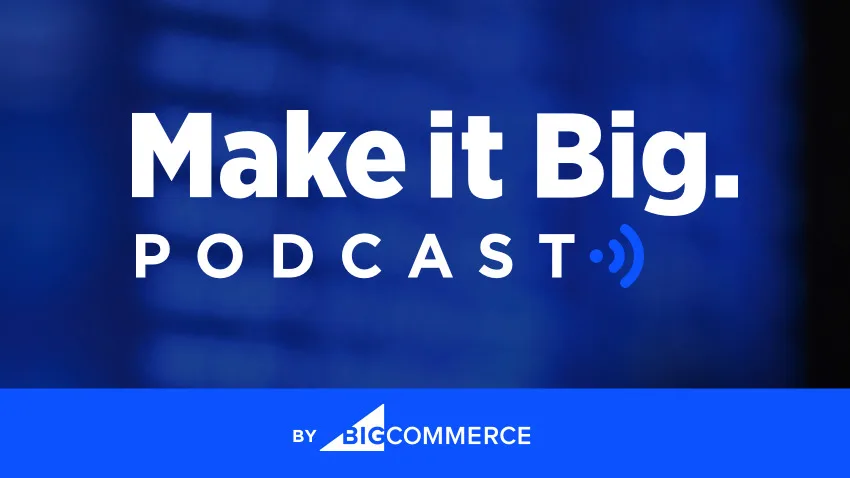
Ecommerce insights on the go
Tune in to the Make it Big Podcast — our thought leadership audio series for retailers, entrepreneurs and ecommerce professionals. You'll get expert insights, strategies and tactics to help grow your business.

Choosing the Right Warehouse Management System for Your Business


Choosing the Right Warehouse Management System for Your Business
Get The Print Version
Tired of scrolling? Download a PDF version for easier offline reading and sharing with coworkers.
A link to download the PDF will arrive in your inbox shortly.
Seventy-seven percent of organizations are interested in automated warehouse systems and mapping a plan to maximize data-driven performance.
For an ecommerce business, that means implementing a warehouse management system.
A warehouse management system, or WMS, is the software and processes that organize and streamline a company’s warehouse to ensure it can operate efficiently. A WMS helps companies control the movement of picking, packing and shipping through their warehouse(s), while offering valuable data and analytics needed to drive the brand’s success.
Let’s dive deeper into the functions of a warehouse management system, uncover telltale signs your business is ready for a warehouse management system, outline ways utilizing a WMS can help your business level up and more.
Functions of a Warehouse Management System
Like the name suggests, a warehouse management system helps manage the functions of your business’s warehouse — but it’s more than just a way to control your facility. A WMS allows you to gain visibility into various aspects of your fulfillment processes and create more efficient workflows.
We’ve outlined the key functions of a warehouse management system below.
Inventory management.
Inventory management is the process of tracking the SKUs in your warehouse, when customers are purchasing them and when you should reorder items.
It’s important to have a clear understanding of how much inventory you have coming in, going out and how much is stocked on your warehouse shelves. A WMS helps you manage your inventory so you can stay informed, set reorder notification points and minimize the risk of both deadstock and overstocking.
Improve inventory accuracy with uploaded images of your products to have additional checks and balances at every stage, location-specific inventory visibility and intelligent cycle counts.
Picking and packing.
Picking and packing orders is one of the primary functions of your warehouse, so it’s important to have a warehouse management system that can help you streamline the process.
A WMS will generate pick lists that have the most efficient routes for warehouse employees to retrieve items that are ready to be packed.
The system should be able to optimize a picker’s route to reduce travel time — for example, to create batch pick lists (choosing items for several of the exact same orders at one time), as well as cluster pick lists (selecting certain items that are part of different orders), depending on warehouse layout and order volume.
By using a WMS, you reduce packing errors thanks to the system’s prescriptive, visual step-by-step packing flows and built-in visuals that shows the pack-out process step-by-step.
A warehouse management system gives you the ability to create efficiencies in the warehouse, improve order accuracy and reduce labor costs.
Shipping.
A warehouse management system also helps keep track of shipping information for orders. You can access order fulfillment metrics across all warehouses, order counts at the picked, packed and labeled statuses and quickly identify orders that need fulfillment prioritized to ensure you ship out the most pressing orders first (i.e. orders with expedited shipping).
The WMS should also provide order routing and carrier selection for the most optimal transportation routes for every order.
When shipping carriers pick up packages directly from your warehouse, your warehouse management system should be able to update your order tracking information so customers can view shipping updates and access their package’s location in transit.
Analytics and reporting.
Warehouse KPIs are crucial metrics to track. As such, your warehouse management system should offer sophisticated analytics in order to help you better understand how you, your staff and your facility are performing.
Your WMS software can help you track throughput, orders picked per hour by associate and other productivity metrics.
Additionally, your WMS should track inventory metrics such as order accuracy rate and inventory turnover rate to ensure your operations are running smoothly and efficiently. A WMS can also help your brand with demand forecasting, so you can make informed staffing and inventory order decisions.
Key Signs of Needing a Warehouse Management System
Each brand has different needs, and there are fulfillment types to suit them all.
Business owners that are just getting started may focus on fulfilling orders from their home, while scaling brands may seek out warehouse space so they have room to grow into.
Depending on the needs of a brand, they may even purchase land and build a custom facility or multiple warehouses.
While using label generation software and spreadsheets might be a good method for brands in their infancy, brands can quickly outgrow those systems and require something more nuanced. A warehouse management system can provide structure, help brands develop workflows to increase warehouse efficiency, offer advanced analytics to inform decision making and more.
Here are some signs that it’s time for your business to implement a WMS:
You need a single-source of truth for warehouse management.
As you’re getting your business off the ground, you’re likely adding on tools and processes as you go. This could mean anything from manually keeping track of your inventory or adopting new ecommerce tools without integrating them.
As your brand scales, putting tools together without a dedicated platform that is made to manage a full-scale warehouse will no longer serve you. And in fact, Frankenstein-ing a bunch of tools together makes things more complicated.
A WMS acts as the centralized system for your entire fulfillment operation. By implementing a warehouse management system, you can connect apps and integrations that route orders and other info from your tech stack, while also providing functionality to oversee every step of operations through one system — such as optimized picking routes, and analytics about inventory, picking and shipping — not just basic functions like shipping label generation.
If you’re using an ERP that doesn’t have WMS capabilities that suit your needs, make sure you get a WMS that at least integrates with the ERP or can easily build into the ERP to ensure seamless data flow.
You struggle with mispicks.
If your fulfillment team struggles with order accuracy, differentiating between similar looking inventory or hiccups during the picking and packing process, it’s likely a sign you’re ready for a warehouse management system that tells you exactly where to go to pick each item, requires validation and scans of each unit as they are picked and packed and had checks and balances in place to reduce errors throughout the fulfillment process.
In fact, many brands may not be aware that a WMS could help solve these issues.
Your brand is growing quickly and can barely keep up with fulfillment.
If you already fulfill orders from your own warehouse, it can be challenging to keep up with orders that are coming in. If you have a growing order volume, you may need a warehouse management solution that has the capacity to scale alongside you.
As your brand scales, you’ll want a system that can accommodate different types of orders (i.e., DTC, B2B, etc.) and can handle multichannel fulfillment. Even if you aren’t fulfilling on multiple channels now, you might need to in the future.
While it might seem like more work to implement a WMS, in the end, the additional processes, visibility and structure will end up speeding up the fulfillment process instead of slowing associates down.
You customize orders and prioritize a specific unboxing experience.
Order customization and branded packaging create a unique experience that today’s customers love. If your operations require a lot of customization during the fulfillment process, fulfilling orders in your own warehouse using a WMS ensures anyone on your team can complete the necessary process without missing any steps.
For example, if you offer specialized kits or bundles and have a vision for how the products are packed (e.g. items get placed in the box a specific way, custom inserts, you use speciality wrapping or tissue paper, etc.), using a warehouse management system that displays visual cues like photos, gifs and other on-screen instructions provides a guide for your packers so they can replicate the packing processes.
This means all customers have the same experience, no matter who packed them, which gives your brand greater brand control.
How Warehouse Management Systems Help Boost Business
There are numerous benefits a WMS can offer your business. The following are some of the most common ways a warehouse management system can help your business level up.
Increased warehouse efficiency and cost savings.
With streamlined warehouse practices, you’re able to save on labor and material costs. When orders are picked and packed using an optimized process, you’re able to use data to better forecast for labor (i.e. when you need seasonal help, when to schedule shifts, etc.).
Utilizing metrics from your WMS, you can improve labor forecasting so you know exactly how many orders each person can fulfill, combined with forecasting tools, to help you plan labor and ensure you have enough staff on site each day.
Improved accuracy rates.
Perhaps the most direct benefit of using a warehouse management system is the improved warehouse processes and workflows.
An organized system for stowing, picking and packing is valuable for your warehouse staff and will allow them to complete orders more quickly and accurately. The multiple checks and balances a warehouse management system requires ensure that associates are completing the correct orders and customers are receiving them on time.
Additionally, by using a WSM, you’re able to boost order accuracy to minimize mispicks, which results in fewer reshipments and loss of inventory.
Scalability.
Using a warehouse management system gives your brand the flexibility to scale. For businesses with high order volume, a growing product catalog and plans to grow, a WMS gives you the tools to grow your business into new geographic markets, sales channels and more without fulfillment slowing you down.
By organizing fulfillment operations, your brand can support larger order volumes without losing productivity, and the time and cost savings can be put towards other growth initiatives.
Improved customer satisfaction.
Believe it or not, implementing a WMS trickles down into how satisfied your customers are. With more efficiencies in place, your packages are being sent out on time and are shipped faster.
Plus, the time you save in the warehouse means you have more time to put into other aspects of the business, such as customer service.
As mentioned, a WMS also contributes to higher accuracy rates, meaning customers are getting exactly what they ordered (and you meet their expectations). This also means your customer service teams are spending less time on resolving support tickets and responding to negative reviews.
Tips for Implementing a WMS
Adopt a system that is easy to implement and use.
Members of your fulfillment team like pickers, packers and even support representatives are heavily hands-on with the software, so it’s important for the system to be simple to navigate on desktop, as well as handheld and wearable devices.
Changing the way things are done is an adjustment, so choosing a user-friendly system makes the transition easier. Whatever system you choose, make sure that all stakeholders and teams can use it, as opposed to just a warehouse manager.
Choose a WMS that connects with your ecommerce store, sales channels and tech stack.
Your business doesn’t exist in a vacuum — you have multiple different platforms and tools within your tech stack that need to be synced so your business can function properly.
Whether it’s your customer service platform accessing order and shipping updates, or your inventory syncing with your DTC store, a warehouse management system should be a centralized point for your apps to pull information from.
Additionally, it’s important that your warehouse management system seamlessly connects with your ERP software or has the capability to have custom integrations built via APIs.
Without this type of connectivity, your platforms are not communicating and sharing information, which can cause compounding issues down the road.
Search for a WMS that enhances your current warehouse setup.
No matter the size of your warehouse, setting up your warehouse can be a stressful task — and it can be even more stressful if your current layout is causing issues.
Some warehouse management systems go so far as to help you set up or improve your current setup to create a more streamlined design. Introducing hardware (i.e. tablets and handheld scanners) and completing warehouse mapping are just two of the options that can help improve your warehouse space.
The layout of your warehouse is something that may change over time. Make sure you choose a system that can easily support changes in horizontal or vertical growth within the warehouse space and make it easy to pinpoint exact locations of each SKU as they enter and exit the building.
Find a system that can deliver advanced analytics.
As the single source of truth for your warehouse operations, your WMS should offer advanced analytics and reporting so you can keep your finger on the pulse of your fulfillment processes.
Your WMS should offer data about order status (e.g. as it changes from in processing, to picked, packed, shipped, etc.), on-time and order accuracy rates, the picking and packing efficiency of associates and more.
Find a software that improves employee productivity.
A WMS is your fulfillment team’s greatest asset. With predetermined picking routes optimized for efficiency, the ability to identify batchable orders to improve productivity and creating a clear process for picking and packing with visuals and scans for real-time data flow, your warehouse management system will help your warehouse staff perform at their best.
Streamline Fulfillment with ShipBob
ShipBob offers its best-in-class technology to businesses operating their own warehouse in the form of our Merchant Plus solution. ShipBob built this proprietary system and utilizes it across our global network — and now businesses can unlock this powerful system to use in their own facilities.
Merchant Plus is an all-in-one WMS, order management system (OMS), inventory management system (IMS) and reporting platform that acts as your single source of truth for fulfillment, showing real-time inventory, shipments and analytics across all online and offline sales channels.
Additionally, Merchant Plus customers can access capacity across ShipBob’s 40+ warehouses utilized by thousands of merchants across the United States, Europe, Australia and Canada to adopt a hybrid fulfillment solution.
ShipBob integrates with BigCommerce and other major ecommerce platforms, so brands can optimize all facets of their fulfillment operations and build a scalable, affordable fulfillment strategy.
In addition to dozens of native integrations, ShipBob’s Developer API allows merchants to build custom integrations in order to make their operations run at its best. Learn more here.
The Final Word
Operating a warehouse has its challenges, so implementing a WMS is a crucial step for scaling ecommerce businesses.
Having a solid warehouse management system in place helps take the guesswork out of how to create efficient workflows and optimize fulfillment strategies (not to mention giving you insight to valuable metrics).

Meredith is a Senior Content Marketing Specialist at ShipBob. ShipBob is a global omnifulfillment platform that helps ecommerce brands fulfill and ship orders, scale into new channels, and access to best-in-class supply chain and logistics capabilities.


